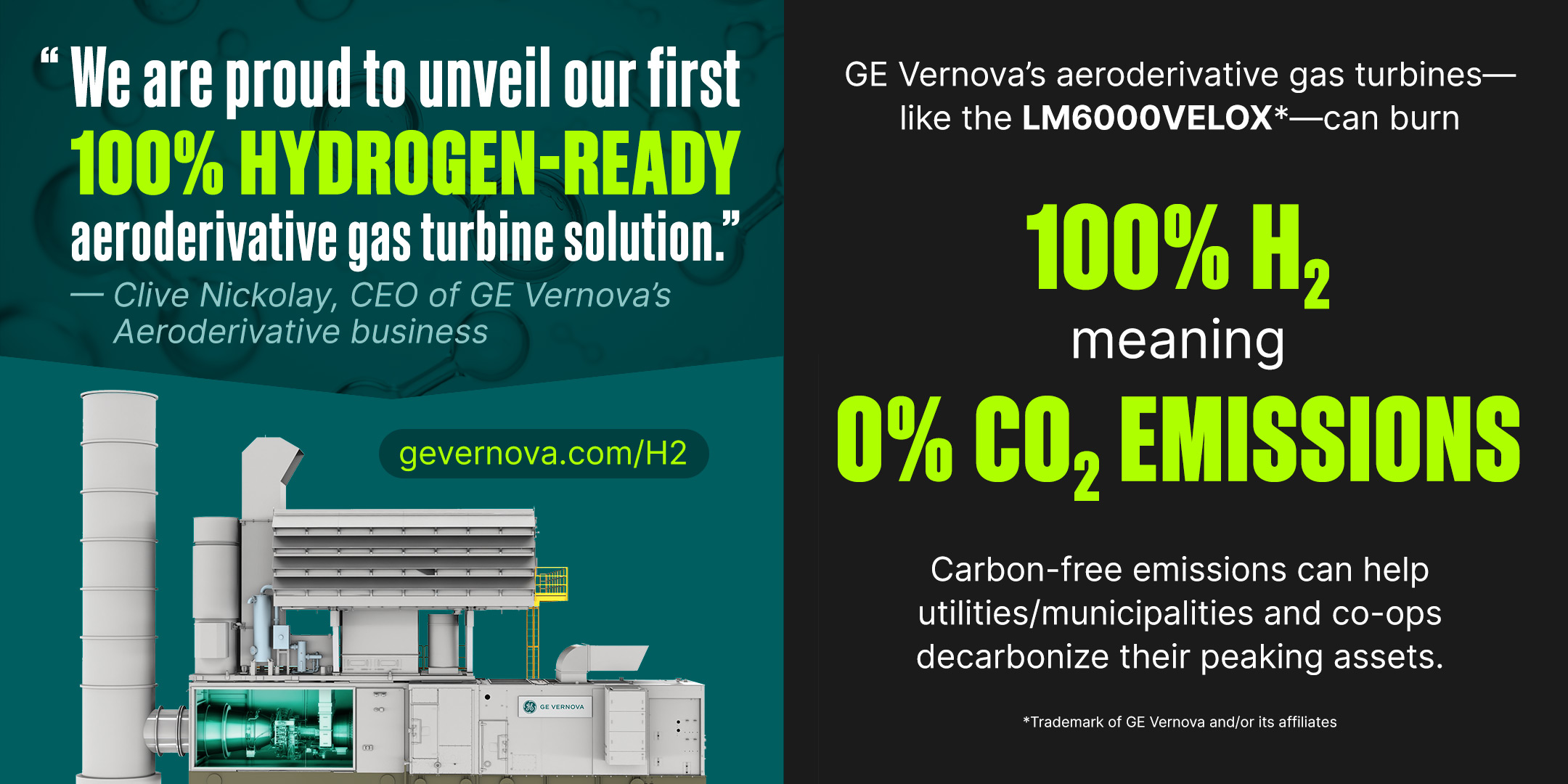Prefer to listen?
Stream our audio version
00:00:00
/
00:00:00
As the global push for decarbonization accelerates, hydrogen (H2) is emerging as a key player in the transition to cleaner energy.
The promise of hydrogen in energy generation
Hydrogen is an incredibly versatile energy carrier. It can be produced from a wide variety of sources, stored for long periods, and burned in turbines to generate electricity. Most importantly, when hydrogen is used as a fuel, the only byproduct is water vapor, making it a carbon-free alternative to fossil fuels.
Gas turbines and hydrogen: A powerful combination
GE Vernova has more experience running gas turbines on hydrogen than any other OEM. In total, GE Vernova has 120+ gas turbines supporting power generation with hydrogen and associated fuels around the world. GE Vernova has combustion technologies that are capable of operating on a wide range of hydrogen concentrations up to ~100% (by volume).
One standout example is the LM6000VELOX, which can burn 100% hydrogen. This capability is a game-changer in the quest for carbon-free power generation. When the LM6000VELOX operates on pure hydrogen, it emits zero carbon dioxide (CO2), making it an ideal solution for utilities and other power producers looking to decarbonize their operations.
Hydrogen capabilities for a greener future
As the energy sector increasingly focuses on decarbonization, the ability to burn hydrogen is a significant advantage. GE Vernova's aeroderivative gas turbines, such as the LM6000VELOX, are capable of burning up to 100% hydrogen. This means zero carbon emissions from the fuel source, offering a viable path for Munis and Co-ops to reduce their carbon footprint and align with sustainability goals.
By integrating hydrogen capabilities, these turbines not only support cleaner energy production, but also help municipalities and cooperatives future-proof their energy assets as the world moves towards a hydrogen economy.

The LM6000 aeroderivative gas turbine: Modular and smaller footprint
The new LM6000VELOX aeroderivative solution aims to reduce the installation and commissioning schedule of LM6000 turbines by up to 40%, saving up to 4,000 labor hours. This translates to an expected 90 days I&C schedule. Thanks to multiple enhanced modularity features, the LM6000VELOX aeroderivative solution is ushering in a new era of speed in the energy industry.
Featured video
LM6000VELOX: Faster power to the grid
With enhanced speed of installation, the LM6000VELOX can provide fast and reliable energy supply to help stabilize the grid when needed.
Decarbonizing Peaking Assets
Peaking assets, which are brought online during periods of high electricity demand, are often dependent on fossil fuels because of their quick-start capabilities and reliability. However, this flexibility comes at the cost of increased emissions. By incorporating hydrogen-burning gas turbines like the LM6000VELOX into their peaking fleets, utilities can reduce their carbon footprint while maintaining the reliability required during peak demand.
This shift is not only beneficial for reducing CO2 emissions but also for enhancing energy security. As hydrogen infrastructure develops and the availability of green hydrogen increases, hydrogen-fueled turbines will provide a more sustainable way to meet peak power needs.
One example of a decarbonizing peaking asset is the Whyalla Hydrogen power facility in South Australia. It is expected to be one of the world’s largest green hydrogen power plant, the facility will use four GE Vernova LM6000VELOX aeroderivative gas turbine packages to convert green hydrogen into electricity in the region.
Conclusion: Powering a carbon-free future
The journey to decarbonization is complex, but at GE Vernova, we believe that hydrogen and other alternative fuels are essential tools in building a sustainable future. Our hydrogen-burning aeroderivative gas turbines, such as the LM6000VELOX, offer a clear pathway to reducing emissions while maintaining the reliability and flexibility that our customers rely on.
By enabling utilities, municipalities, and cooperatives to decarbonize their peaking assets, GE Vernova is playing a crucial role in shaping the future of energy—one that is cleaner, more sustainable, and ultimately, carbon-free.
As hydrogen production and infrastructure continue to grow, we are confident that our turbines will be at the forefront of this energy revolution, providing the world with the power it needs—without the emissions it doesn’t.

Olamide Ogunduyile
Technical Sales Executive, Aeroderivative Gas Turbines, GE Vernova
Olamide has 18 years of power plant, industrial controls, product development, engineering management and sales development experience. As a Global Sales Executive for GE Vernova’s Aeroderivative Gas Turbines business, he is responsible for leading a team of technical sales specialists responsible for growing order intake globally. Olamide received his B.Sc. degree in Electrical Engineering from Drexel University and an MBA degree from Fisher College of Business at The Ohio State University.
Customer stories
Contact us



